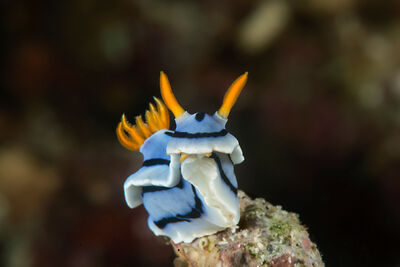From the bright red Spanish dancer to Hopkins's rose nudibranch, neon green leaf sheep nudibranch - otherwise known as 'Shawn the Sheep' -, and the orange-peel Doris nudibranch, fabulously coloured nudibranchs have amassed a cult-like following among divers. Hailed as the 'Jewels of the Ocean,' there are over 3,000 species of nudibranch plying the world's oceans with adaptations as varied as their colours. From nudibranchs harnessing jellyfish stings for defence (we're looking at you, blue glaucus) to solar-powered nudibranchs, discover ten nudibranch facts about these technicolour sea slugs.

FACT 1: A Nudibranch's Colour Is a Warning
It's no secret that nudibranchs come in every colour under the sun, however, much like most brightly coloured, slow-moving species, these kaleidoscopic colours are a warning to predators to stay away. Nudibranch - meaning naked gill - descended from shelled molluscs, however, lose their shells after their larval phase. From this point, they rely on toxins or unpleasant tasting chemicals for protection, which they advertise with extremely vivid colours.
FACT 2: Nudibranchs Use Tentacles to Smell
Nudibranchs have two rhinophores on top of their heads which they use to smell. These worm-like tentacles can be a target for peckish fish, so most nudibranchs have adapted the ability to retract their rhinophores into a pocket in their skin to avoid them getting nipped off.

FACT 3: Nudibranchs Are Hermaphrodites
Slow-moving nudibranchs are called sea slugs for a reason. Therefore, unsurprisingly, finding a mate can be tricky. In order to maximize their chances of reproducing, nudibranchs have a curious adaption.. Depending on if the other nudi is male or female, nudibranchs will change their sex so that they are always able to mate.
FACT 4: Some Nudibranchs Produce Solar Power!
Certain species of nudibranch, like the sap sucking slug (Sacoglossans) produce solar power by eating corals. Corals contain an algae, called zooxanthellae, which nudibranchs absorb allowing them to photosynthesize. This energy source allows nudibranchs to survive for several months without eating.

FACT 5: Nudibranchs Have Varied Diets
You are what you eat, and for nudis the prey they consume often gives them their bright colours. A true nudi is carnivorous and uses a powerful jaw - known as a radula - to grate and scrape food off rocks. Typical nosh consists of ascidians, hydras, sponges, fish eggs and bryozoans. However, some nudis feed on toxic animals and then store the toxins in specialised cells to aid in their own defence. There are also cannibal nudis, while others are fussy eaters and will only eat one type of prey.
FACT 6: Both Nudibranch Parents Lay Eggs
Because nudibranchs are hermaphrodites, after a sexual encounter both nudis become pregnant and will therefore both give birth to nudi hatchlings. Double the nudis for just one encounter!

FACT 7: Nudibranchs Can Cut Off Body Parts to Survive
One of the most unusual nudibranch facts is that they can survive by autonomy. Just like a gecko can ditch its tail to escape and grow it back, nudis can get rid of their rhinophores, branchial plumage or a fragment of their mantle in order to save the vital core of their body, which it will then regenerate later.
FACT 8: Some Nudibranchs Do Not Eat
Some nudibranch species have the ability to store photosynthetic algae inside their bodies. They only need to eat for the first few weeks of their life and once they have enough, the algae provides enough energy from photosynthesis for the both of the algae and the nudi.

FACT 9: Nudibranchs Communicate With Slime
Similar to their land counterparts - slugs - nudibranchs leave a trail of slime behind them. This trail is a unique marker filled with chemicals used to communicate with other nudibranchs. While we don't speak nudibranch, this might be to find a potential partner to mate with or even warn others of danger.
FACT 10: Nudibranchs Live Short Lives
While most nudibranch species typically live up to one year, some may only live a few weeks! The oldest nudibranch recorded was four years old.












